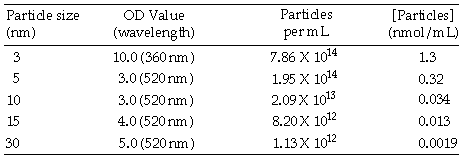Technical Help: Colloidal Gold
Discontinued Product
Got a question? We can help.
Talk with our scientists in Tech Support.
We're scientists too, and we use all our products in our own research.
We look forward to helping you with your project!
FAQ
See also
- Guide to Gold Nanoparticle Labeling
Detailed description of gold nanoparticle labeling, tips and tricks for successful conjugations, isolation of conjugates, and how to calculate labeling.
I can't see the FAB-3 particles as clearly as I had anticipated
Sometimes the 3 nm particles show up more clearly in prints than they appear to the naked eye. Try printing the image. Alternatively, try a simple blot test to determine whether you still have an active conjugate: spot a specific target antigen (e.g. mouse IgG if you have anti-mouse FAB-3) onto nitrocellulose membrane, block with BSA, incubate with the FAB-3 conjugate, then enhance with silver. If the antigen spots are visualized, it is still functional. For a more detailed procedure, see our product instructions.
Catalog Info | Blotting instructions | References
What are the concentrations of colloidal gold particles in your preparations, and how many antibody molecules are bound per gold particle?
From spectroscopic measurements on freshly prepared colloidal gold sols of different sizes, we have calculated the concentrations of gold particles in our commercial preparations of colloidal gold. These values assume that all the tetrachloroaurate used for the preparation is converted to colloidal gold, and that the gold particles are composed of metallic gold of density 19.31 grams per mL:

We have also calculated the approaximate numbers of IgG molecules and streptavidin which can adsorb to our gold particles. These values are based on a contact area for IgG of 45 nm2, and for streptavidin of 25 nm2, and assume that the IgG or streptavidin molecules cover 50 % of the surface area of the gold particles:

Please note: these values are estimates based on assumptions, and have not been confirmed by experimental measurements of size, particle counting, or determination of adsorbed antibodies or streptavidin.
Catalog Info | Blotting instructions | References
Can I use your non-functional colloidal gold particles (catalog numbers CG0300 to CG3000) to label my own antibodies, proteins, or other biomolecules?
Our non-functional colloidal gold particles are coated with bovine serum albumin and/or carbowax: they are therefore stable towards further binding, and cannot be used to label your own biomolecules. They are intended for use either as tracers or as size standards.
We have extensive experience with unusual conjugations and labeling reactions: if you would like a specific colloidal gold conjugate which we do not list in our catalog, or would like to conjugate an unusual type of molecule to colloidal gold, please e-mail us, telephone or write to inquire about it. Details of our custom labeling services are given on our custom synthesis page.
Catalog Info | Blotting instructions | References
I have an experiment which requires larger sizes of colloidal gold than 30 nm. Can you make these or conjugate them?
Preparations have been described for colloidal gold particles up to 64 nm in diameter (see the reference below). However, colloidal gold particles become less stable - more sensitive to salts and to their environment, and more prone to flocculation and aggregation - as they become larger. Therefore, although we may be able to prepare colloidal gold up to 64 nm, we suggest that you investigate preparing it locally rather than ordering from us.
Colloidal gold particles larger than 64-150 nm have not been described. For particles of 100 nm (0.1 micron) or larger, which are microparticles rather than colloids, we suggest that you consider a commercial source of finely divided metals or microparticles made from other materials to which smaller gold particles may be conjugated.
Catalog Info | Blotting instructions | References
What are the size distributions of your colloidal gold particles? Is a histogram available?
Our 30 nm colloidal gold conjugates have been analyzed by transmission electron microscopy. The standard deviation for the size was ± 3.4 nm to 3.6 nm, or about 10 % of diameter. Size distributions have not been determined for smaller colloidal gold reagents.
Catalog Info | Blotting instructions | References
Any tips for other users?
Things you'd like to see us make?
Tell us about your question at tech@nanoprobes.com.
|